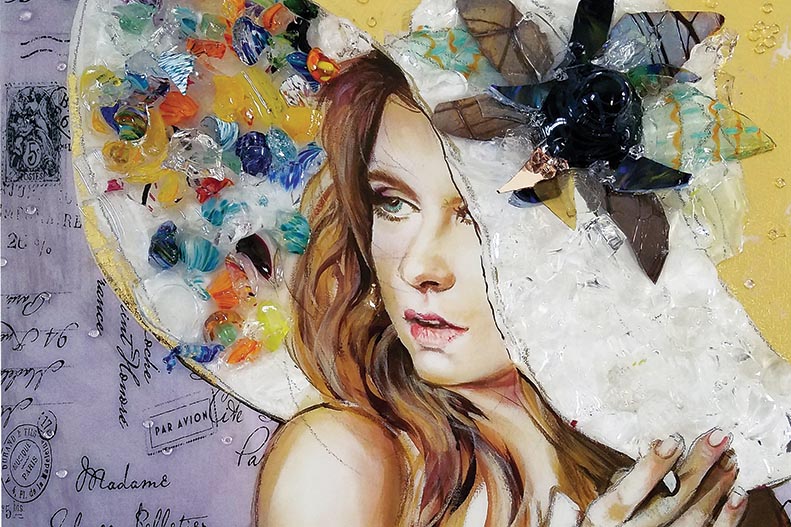
A serene landscape of Big Sur’s roiling coastline seems to glow through the gallery window on the right. To the left, a four-foot-tall face of a woman decked out in multicolor Day of the Dead garb gazes down through the glass. Both represent Carmel’s vibrant art scene, despite their obvious differences. Carmel is welcoming two new art galleries, which cater to the vastly differing tastes of the art buying public. Coastal landscapes and sculptures of the human form aren’t going anywhere, but the variety of styles of art available in Carmel continues to broaden with the addition of these new contemporary and pop art galleries that now call Carmel their permanent home.
In the streets off downtown’s Ocean Avenue, one will find beautiful and traditional early California works in galleries, including Carmel Fine Art, Karges Fine Art and Portnoy Galleries. Oil paintings depicting the cliffs of Big Sur, the Carmel Mission or our famous Monterey cypress trees fill every inch of their walls. Now, amongst these nature scenes, Carmel residents and long-time visitors will notice something less familiar: the eccentric pop art of Greg Creason. “I never thought what I created would get this much attention,” says Greg Creason, owner of Creason’s Fine Art Gallery on the corner of Dolores Street and 6th Avenue. Creason creates towering portraits of women, differing in age and ethnicity, with paint, glass, foil and other mixed media to liven up their personalities. The kaleidoscopic colors and playful textures are a stark contrast to the classic, yet muted earth tones of the early California paintings in neighboring galleries. Creason says the time is finally right for him. “Carmel, up until recently, was not ready for my style of artwork.”
Having worked for Thomas Kinkade and Richard MacDonald for several years in the 1990s, Creason roamed the streets of Carmel with hopes of being featured in one of the nearly 100 art galleries. Instead, he was able to bypass that step and open his own in August of 2020. Creason believes that challenging traditions benefits the art scene. “I consider ourselves an orange in a basket of apples, because we’re something that’s a little different, and I think it’s time for Carmel to [go through] what we call a ‘changing of the guard.’”
With more opportunities for eccentric art to be featured comes a generation of young artists moving to the Peninsula to create in the same place that their work is sold. Henry Bunkall, a contemporary artist from Southern California with a spotlight feature in the Monica Graham Fine Art Gallery, isn’t finding it hard to fit in. Bunkall says diverse genres are important for the community. “A representational landscape painting can uniquely complement a non-representational abstract painting, and vice versa. The juxtaposition of both creates a more sophisticated art scene as a whole,” says Bunkall, whose paintings are characterized by boldly colored lines and abstract brush strokes. “Carmel is very much alive in that it embraces the new wave of art, while maintaining its deep artistic roots.”
The success of Creason’s gallery in Carmel correlates with the desire for something new and different. “You’re starving for something different and unique…we’ve had many people come in that have been in Carmel forever and they’re like, ‘Thank God, somebody’s here to shake things a little bit,’” says Creason. Aside from the need for diversification, this change in the art scene can be attributed to buyers feeling less intimidated by contemporary art. Art Consultant, Monica Graham, of Monica Graham Fine Art, says that during a panel she held in 2016 called “Buying Art 101,” many collectors confessed that the classic art galleries were intimidating to walk into, and they didn’t always “connect” with those works. Graham believes a more relaxed atmosphere in contemporary galleries has “opened a whole new world” of art in Carmel.
The inclusion of more playful pieces has faced criticism from some bold observers. To Creason, Carmel’s conventional landscapes are considered “safe art,” and his work being so drastically different, is far from safe. “I get crazy, really off the wall comments…people that are used to a certain type of thing.” Sometimes it’s as simple as a passerby exclaiming that his work is not for them, but other times it can be more severe. “It’s a unique place to be an artist and putting your wears on the wall, this is your heart and soul, and it’s interesting because [people] have no problem telling you if they like it or not.” The majority of the time, though, his work is praised by visitors. When asked who his audience is, Creason says, “I painted for people at one point, and I realized that people don’t know what they want. So, I started painting for myself, and that’s why it’s developed into what it has.” Though he is not painting for a specific type of person, he says his buyers’ demographics typically range in age from 30s to 60s.
According to the artists, newcomers setting up shop next to the big players who have been established for many decades need not feel discouraged. A risk of rejection always exists, but the potential reward is too great to not be reaped. “Carmel is a place with ample opportunity for everyone working in the arts, and that’s why I feel motivated as opposed to intimidated,” says Bunkall. “This sort of atmosphere creates an enthusiasm, which in turn ignites the spark.” Creason, who waited until he got to a certain level of confidence to open his showroom in Carmel, has three main pieces of advice for artists wanting to make a name for themselves in established art centers: Accept the fact that society will either accept you or reject you, have a story behind your mission and have a support system. From the looks of the new wave of art collectors, he and other contemporary artists are getting the support they need.